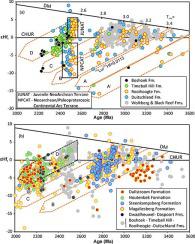当前位置:
X-MOL 学术
›
Precambrian. Res.
›
论文详情
Our official English website, www.x-mol.net, welcomes your
feedback! (Note: you will need to create a separate account there.)
Zircon U-Pb-Hf isotope systematics of Transvaal Supergroup – constraints for the geodynamic evolution of the Kaapvaal Craton and its hinterland between 2.65 and 2.06 Ga
Precambrian Research ( IF 3.2 ) Pub Date : 2020-08-01 , DOI: 10.1016/j.precamres.2020.105760 Armin Zeh , Allan H. Wilson , Axel Gerdes
Precambrian Research ( IF 3.2 ) Pub Date : 2020-08-01 , DOI: 10.1016/j.precamres.2020.105760 Armin Zeh , Allan H. Wilson , Axel Gerdes

|
Abstract The Transvaal Basin in South Africa hosts a 15 km thick pile of sedimentary successions deposited over a period of >600 Ma during the Neoarchean to Paleoproterozoic. Presently, little is known about the source of these sediments, as well as about the tectono-magmatic evolution in the hinterland of the Transvaal Basin, preventing detailed geotectonic correlations of the Kaapvaal Craton (KC) with other cratons worldwide. To solve this problem, we present the first systematic study of combined U-Pb and Lu-Hf isotope data of >2000 detrital zircons from fourteen formations of the Transvaal Supergroup. These reveal that clastic sedimentary rocks were supplied from sources on and off the present-day KC. Detrital zircons in conglomerates of the Wolkberg and Black Reef formations, maximum deposition ages at 2769 ± 8 and 2618 ± 11 Ma respectively, were mainly supplied from surrounding KC, either from Pietersburg Block Basement (PBB), and/or from eroded sedimentary successions of the Witwatersrand, Pongola and/or Ventersdorp Supergroups. In contrast, clastic sedimentary rocks of the Rooihoogte, Duitschland and Timeball Hill formations (maximum deposition ages at 2353 ± 18 Ma, 2342 ± 18 and 2290 ± 8 Ma, respectively) were predominately supplied from a juvenile Neoarchean terrane (JUNAT) formed at 2570–2500 Ma (eHf2500 Ma = +2 to +9) and intensely reworked at 2400 Ma, and to a minor amount from a composite Archean terrane (CAT) emplaced by granitoids between 3540 and 2680 Ma, and affected by crust reworking at 2570–2430 Ma (eHf2.5Ga = −3 to −12) in a Neoarchean to Paleoproterozoic continental arc terrane (NPCAT). Subsequent periodic reworking of JUNAT at 2250–2220 Ma and 2120 Ma is recorded by detrital zircons in sandstones of the overlying Boshoek, Dwaalheuwel, Daspoort, Magaliesberg and post-Magaliesberg formations, having maximum deposition ages at 2243 ± 7, 2242 ± 7, 2240 ± 7, 2080 ± 7, and 2068 ± 7 Ma, respectively. The Archean zircons (age >2650 Ma) in all these formations were mainly supplied from PBB. The new data sets also suggest that the KC was connected to CAT, NPCAT and JUNAT at
中文翻译:

德兰士瓦超群锆石 U-Pb-Hf 同位素系统学——卡普瓦尔克拉通及其腹地在 2.65 和 2.06 Ga 之间地球动力学演化的约束
摘要 南非的德兰士瓦盆地拥有 15 公里厚的沉积层序堆积,沉积时间超过 600 Ma,在新太古代到古元古代期间沉积。目前,对这些沉积物的来源以及德兰士瓦盆地腹地的构造岩浆演化知之甚少,这阻碍了卡普瓦尔克拉通 (KC) 与世界其他克拉通的详细大地构造关联。为了解决这个问题,我们首次系统研究了来自德兰士瓦超群的 14 个地层的 >2000 颗碎屑锆石的 U-Pb 和 Lu-Hf 同位素数据。这些表明碎屑沉积岩是由现今 KC 内外的来源提供的。Wolkberg 和 Black Reef 地层的砾岩中的碎屑锆石,最大沉积年龄分别为 2769±8 和 2618±11 Ma,主要来自周围的 KC,或者来自彼得斯堡地块基底 (PBB),和/或来自 Witwatersrand、Pongola 和/或 Ventersdorp 超群的侵蚀沉积层序。相比之下,Rooihoogte、Duitschland 和 Timeball Hill 地层的碎屑沉积岩(最大沉积年龄分别为 2353 ± 18 Ma、2342 ± 18 和 2290 ± 8 Ma)主要来自于 2570 年形成的新生新太古代地体(JUNAT) –2500 Ma(eHf2500 Ma = +2 至 +9),并在 2400 Ma 进行了强烈的再加工,以及在 3540 到 2680 Ma 之间被花岗岩侵位的复合太古代地体(CAT)以及在 2570 年受到地壳改造影响的少量- 2430 Ma (eHf2.5Ga = -3 到 -12) 在新太古代到古元古代大陆弧地体 (NPCAT) 中。随后 JUNAT 在 2250-2220 Ma 和 2120 Ma 的周期性改造被上覆 Boshoek、Dwaalheuwel、Daspoort、Magaliesberg 和 post-Magaliesberg 地层的砂岩中的碎屑锆石记录,最大沉积年龄为 2243±2247±2247, ± 7、2080 ± 7 和 2068 ± 7 Ma。所有这些地层中的太古代锆石(年龄 >2650 Ma)主要来自 PBB。新数据集还表明 KC 与 CAT、NPCAT 和 JUNAT 在 2650 Ma) 在所有这些地层中主要由 PBB 提供。新的数据集还表明 KC 与 CAT、NPCAT 和 JUNAT 在 2650 Ma) 在所有这些地层中主要由 PBB 提供。新的数据集还表明 KC 与 CAT、NPCAT 和 JUNAT 在
更新日期:2020-08-01
中文翻译:

德兰士瓦超群锆石 U-Pb-Hf 同位素系统学——卡普瓦尔克拉通及其腹地在 2.65 和 2.06 Ga 之间地球动力学演化的约束
摘要 南非的德兰士瓦盆地拥有 15 公里厚的沉积层序堆积,沉积时间超过 600 Ma,在新太古代到古元古代期间沉积。目前,对这些沉积物的来源以及德兰士瓦盆地腹地的构造岩浆演化知之甚少,这阻碍了卡普瓦尔克拉通 (KC) 与世界其他克拉通的详细大地构造关联。为了解决这个问题,我们首次系统研究了来自德兰士瓦超群的 14 个地层的 >2000 颗碎屑锆石的 U-Pb 和 Lu-Hf 同位素数据。这些表明碎屑沉积岩是由现今 KC 内外的来源提供的。Wolkberg 和 Black Reef 地层的砾岩中的碎屑锆石,最大沉积年龄分别为 2769±8 和 2618±11 Ma,主要来自周围的 KC,或者来自彼得斯堡地块基底 (PBB),和/或来自 Witwatersrand、Pongola 和/或 Ventersdorp 超群的侵蚀沉积层序。相比之下,Rooihoogte、Duitschland 和 Timeball Hill 地层的碎屑沉积岩(最大沉积年龄分别为 2353 ± 18 Ma、2342 ± 18 和 2290 ± 8 Ma)主要来自于 2570 年形成的新生新太古代地体(JUNAT) –2500 Ma(eHf2500 Ma = +2 至 +9),并在 2400 Ma 进行了强烈的再加工,以及在 3540 到 2680 Ma 之间被花岗岩侵位的复合太古代地体(CAT)以及在 2570 年受到地壳改造影响的少量- 2430 Ma (eHf2.5Ga = -3 到 -12) 在新太古代到古元古代大陆弧地体 (NPCAT) 中。随后 JUNAT 在 2250-2220 Ma 和 2120 Ma 的周期性改造被上覆 Boshoek、Dwaalheuwel、Daspoort、Magaliesberg 和 post-Magaliesberg 地层的砂岩中的碎屑锆石记录,最大沉积年龄为 2243±2247±2247, ± 7、2080 ± 7 和 2068 ± 7 Ma。所有这些地层中的太古代锆石(年龄 >2650 Ma)主要来自 PBB。新数据集还表明 KC 与 CAT、NPCAT 和 JUNAT 在 2650 Ma) 在所有这些地层中主要由 PBB 提供。新的数据集还表明 KC 与 CAT、NPCAT 和 JUNAT 在 2650 Ma) 在所有这些地层中主要由 PBB 提供。新的数据集还表明 KC 与 CAT、NPCAT 和 JUNAT 在











































 京公网安备 11010802027423号
京公网安备 11010802027423号